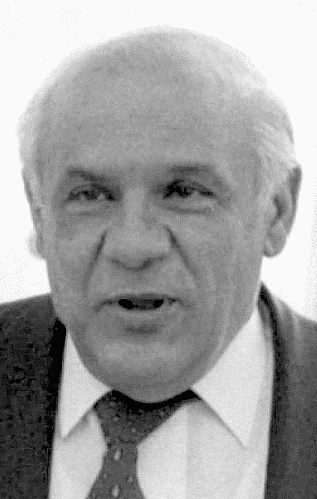
Mangano
Venero Frank "Benny Eggs" Mangano, one of the Genovese Crime Family's oldest and strongest remaining links to its traditional Lower West Side foundation, died of natural causes in Manhattan's Greenwich Village on August 18, 2017. He was ninety-five years old. [1]
The Greenwich Village area was a stronghold of the organization that became known as the Genovese Family since a young Vito Genovese joined forces with Giuseppe "Joe the Boss" Masseria in the Prohibition Era.
Venero Mangano's parents, newcomers to the United States, settled in the area in the early 1910s. His father, who shows up in records with the names Venero and Giuseppe/Joseph, was a native of the town of Linguaglossa in the eastern Sicilian province of Catania. [2] He married Carmela Pagano, also referred to in records as "Melly" and "Mary," in Manhattan on December 13, 1914. [3]
At the time of the 1920 Census, shortly before the birth of "Benny Eggs," the family resided at 58 Thompson Street on Manhattan's Lower East Side. The family patriarch reported that he worked as a farm laborer (perhaps as a chicken farmer). The household included the couple's son John, almost three years old, and daughter Concetta, eight months old, as well as a brother-in-law Angelo Raia. [4]
Mangano in-laws named Bonano and Lamara lived nearby at 72 Thompson Street. [5]
The couple's third child, Venero Jr., who would become notorious as Mafioso "Benny Eggs," was born in Manhattan in September 1921. [6]
The father of Benny Eggs' longtime underworld ally arrived earlier in that year. Salvatore Esposito Vulgo Gigante, a native of the Naples region of mainland Italy, entered the United States on January 4, 1921. [7]
The Mangano family traveled to Sicily in 1923 and returned to New York City in the spring of 1924. Initially upon their return, they went to stay with the Bonano family at 72 Thompson Street. [8] They soon moved into an apartment at 88 Thompson. Benny Eggs' father, using the name Joseph, ran an egg store, which provided young Benny with the nickname he would carry the rest of his life.
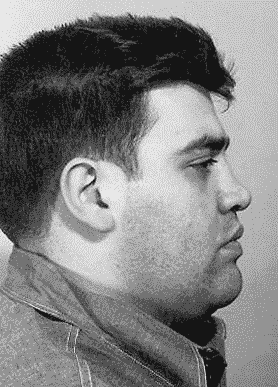
Gigante
In that period, a few blocks north of the Mangano home (just inside the traditional southern boundary of Greenwich Village), a son was born to Salvatore E.V. and Yolanda Gigante at 177 Thompson Street. The child - the third son born to the couple - was named Vincent. Family members shortened the name to "Chenzo" or "Cinzino," and over time he became known as "Vinny the Chin." [9]
Late in 1928, Benny became the second-youngest child in his family, when his brother Sam was born. [10]
As Benny Eggs and Vinny the Chin grew up, Greenwich Village became the center of an underworld empire, through the influence of Neapolitan racketeer Vito Genovese. By 1930, Genovese was part of Masseria's Mafia organization. Following the Castellammarese War, Genovese became underboss of the organization under new chief Salvatore "Charlie Luciano" Lucania. Lucania and Genovese moved wholeheartedly into labor racketeering and gambling as the Prohibition Era drew to a close.
Through expanding influence in the locals of the International Longshoremen's Association, their crime family came to control illegal activity along Manhattan's West Side docks and those of nearby New Jersey. [11]
When the United States entered World War II, Venero "Benny Eggs" Mangano enlisted in the armed forces. At the time, he was five-foot-four and 145 pounds, had not finished high school and was working as waiter. Mangano served his country with distinction as a tail-gunner in bomber aircraft. He flew thirty-three missions over Europe, including two bombing runs on D-Day. He earned the Distinguished Flying Cross and an Air Medal with four Oak Leaf Clusters (each indicating performance worthy of an additional Air Medal) and three Battle Stars (indicating participation in three distinct phases of the war). [12]
In that period, the Gigante family moved a couple of blocks deeper into Greenwich Village, renting an apartment at 238 Thompson Street, close to Washington Square Park. [13]
Early rackets

Genovese
When Mangano returned from the U.S. Army Air Force, he settled into rooms at 166 Thompson. [14] He must have become involved in the rackets almost immediately. Mangano's first brush with the law occurred in 1946. It resulted in an October 7 conviction for bookmaking and a fine of $50. Seven months later, he was again convicted of bookmaking. He was fined $200 for that offense. [15]
It is likely that Mangano's bookmaking enterprise was run with the approval of the Greenwich Village-based faction of the future Genovese Crime Family.
Crime family boss Salvatore "Charlie Luciano" Lucania was in prison through World War II, sentenced to 30 to 50 years for compulsory prostitution. In 1946, the remainder of his sentence was commuted on the condition that Lucania be deported to his native Italy. [16] Lucania underboss Vito Genovese spent the war years in Italy and worked with the occupying Allied forces there immediately afterward. He was returned to the United States in June 1945 to face charges in connection with the 1934 murder of Ferdinand "the Shadow" Boccia. When a key witness died mysteriously in prison, the case against Genovese collapsed. Frank Costello managed the crime family while its two top men were busy elsewhere. In the 1950s, Genovese and Costello competed for control of the organization. The conflict concluded in 1957, when Genovese soldier Vincent "Chin" Gigante, then a resident of 134 Bleecker Street, fired a bullet at Costello's head. Costello survived the assassination attempt but stepped aside, allowing Genovese to take over as boss. [17]
Additional Mangano bookmaking convictions occurred in October 1950 and February 1961. The first of those earned him another $200 fine. The next resulted in a $250 fine and a ninety-day prison term. [18]
Venero Mangano married Louise Brunelli in 1961. Brunelli was raised in Greenwich Village. Her childhood home was an apartment on Bleecker Street between Sixth and Seventh Avenues. Outwardly, Mangano managed M&J Industries, which bought up surplus designer clothing at discount and sold it to markets in the U.S. and overseas. At the same time, he was entering into new underworld rackets and becoming an important figure within the Greenwich Village crew that dominated the Genovese organization. [19]
In the early 1960s, Vito Genovese was removed from day-to-day operations of the crime family bearing his name. He was imprisoned on a narcotics conviction. The organization was managed by a panel of Genovese's top men. Following Genovese's death, the mysterious Philip "Benny Squint" Lombardo served as boss. Lombardo avoided a great deal of law enforcement scrutiny by operating behind a series of "front men." [20]
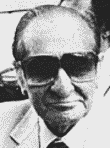
Tieri
Venero Mangano emerged as a key figure in Genovese Family labor racketeering when Australian businessman Peter Abeles opened the Thomas Nationwide Transport trucking company in the New York area. The company experienced bombings, arson and strikes until it began paying labor "consulting fees" to Mangano and Lawrence "Buddy" Garaventi. Authorities became aware of payments totaling $250,000. The trucking company acknowledged making the payments but insisted they were for legitimate consulting services. [21]
In the mid-1970s, Mangano served as a sort of gatekeeper to the upper echelon of the crime family. When Aladena "Jimmy the Weasel" Fratianno, temporary leader of the Los Angeles Mafia, went to New York to meet with Genovese leaders, he was put in touch with Mangano. Mangano reportedly told Fratianno to visit clothing store Resource Sales Corporation, 137 Varick Street near Spring Street on Manhattan's Lower West Side, at two o'clock in the afternoon. When Fratianno arrived there, he found Mangano and Anthony "Fat Tony" Salerno in the shop. Fratianno and Salerno spoke for a time. Then Mangano escorted Fratianno to a small, dingy cafe, where Frank "Funzi" Tieri was the only apparent customer. (The cafe may have been the Triangle Social Club made famous as Vincent Gigante's headquarters.) Tieri was serving as front man for Lombardo at the time, but he was perceived as the family's top boss by all but Lombardo's inner circle. Mangano introduced Fratianno and then left the two men in private conversation. [22]
The FBI in the mid-1970s worked to expose the influence of racketeers over the International Longshoremen's Association. The Bureau's UNIRAC (short for Union Racketeering) case investigated ILA relationships with Mafiosi from the Genovese and Gambino crime families. The case, involving dozens of agents through several years, is recalled as the FBI's first major labor racketeering investigation. On Dec. 18, 1978, a grand jury in Miami, Florida, indicted 22 union officials and shipping company executives for illegal activities. That was just the initial blow. Additional indictments were returned in New York City and elsewhere. UNIRAC resulted in the convictions of Gambino capodecina Anthony Scotto, Genovese capodecina Michael Clemente and more than 100 other individuals. [23] UNIRAC turned out to be little more than a "glancing blow" at waterfront racketeering. (Thomas Gleason, considered a Genovese puppet, served as president of the ILA until 1987, and a son of Vincent Gigante was vice president of a dockworker's union in the 1980s.) [24]
New regime

Gigante
With the death of Tieri and the retirement of Lombardo in 1981, Vincent Gigante moved into the position of Genovese Crime Family boss. Following Lombardo's example, Gigante shielded himself by using Salerno as a front man. He also sought to avoid law enforcement scrutiny by public posing as mentally ill and having close associates speak about him dismissively as "crazy."
During Gigante's reign, the "seedy" Triangle Social Club (also known as the Triangle Civic Improvement Association) at 208 Sullivan Street in Greenwich Village and the village streets where "crazy" Gigante wandered at night in bathrobe and slippers comprised the Genovese Family headquarters. The boss was also regularly found at his mother's apartment at 225 Sullivan Street, though he had two homes (and families) at Old Tappan, New Jersey, and 67 East 77th Street in Manhattan. [25]
By that time, Gigante and Mangano were old friends. Gigante's rise to the position of boss, further enhanced Mangano's position. "Benny Eggs" was known for his subtle efficiency and his strict adherence to the Mafia's "omerta" code of non-cooperation with authorities. Following the change in family leadership, Mangano found himself in federal custody.
Mangano had been called as a witness in a Pennsylvania federal court. He refused to testify. The Justice Department granted him immunity from prosecution, and he was again called upon to testify. Again he refused. The court found him in contempt and locked him up. He remained in custody from August 18, 1981, until April 22, 1982. [26]
Despite the courtroom setback, federal agents continued to try to extract information from the sixty-year-old Mangano while he was in custody. In November of 1981, agents questioned him on his business relationships with an underworld-linked Dallas businessman named Victor Nitti. Nitti had pleaded guilty to perjury as well as conspiracy to bribe workers at Dallas-based Army-Air Force Exchange Service (Nitti's former employer) to gain contracts for his own company. [27] Investigators hoped to establish connections to Mafia leadership, but learned nothing from Mangano.
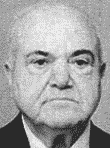
Salerno
Law enforcement obtained information on the new hierarchy of the Genovese Family in 1982 but had trouble gathering evidence of wrongdoing against the leaders. The Palma Boys Social Club, 416 East 115th Street in East Harlem, where "Fat Tony" Salerno spent a great deal of time, came under intense surveillance without any immediate positive result. The attention of agents fell upon the Triangle Social Club. Behind its covered windows, the club was a twenty-foot-by-twenty-foot room with a small bathroom at the left rear. Near the front stood a short bar with a coffee machine mounted to it and some pinball machines. Deeper in the dimly lit club were some counters and a long table. Near the bathroom was a smaller table, where Gigante regularly sat. [28]
The FBI decided that installing electronic surveillance at the Triangle club would be of little use. Agents noted that Gigante spoke with other crime family members only in whispers and usually on outdoor walks through Greenwich Village. Gigante was regularly seen with "Benny Eggs" Mangano, Dominick "Quiet Dom" Cirillo of the Bronx, and Dominick "Baldy Dom" Canterino.
Agents noted that Mangano operated his own social club on Thompson Street, a short distance from Gigante's Triangle. Mangano kept his club open to senior citizens from the neighborhood, who would visit to play cards and socialize. The club was reportedly decorated with American flags and photographs of Italian-American celebrities, such as Frank Sinatra and Perry Como. FBI records indicated that Mangano was involved in bookmaking, loan sharking and labor extortion. [29]
Mangano was often accompanied by John "Sausage" Barbato of Staten Island. Agents began referring to "Benny Eggs" Mangano and "Sausage" Barbato as "Chin's Breakfast Club." [30]
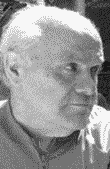
Mangano
Accusations relating to the Thomas Nationwide Transport payments surfaced in the early 1980s, as Aladena Fratianno began cooperating with authorities. In the summer of 1982, Fratianno's information resulted in charges of conspiracy to evade income taxes against Venero Mangano and an associate, reportedly recipients of the $250,000 in consulting fees paid by Thomas Nationwide Transport. [31]
Regional authorities in the following year identified Mangano as a Genovese Family caporegime and an organizer of illegal activities on the New York-New Jersey waterfront. Mangano, it was reported, received regular payments from businesses along the Hudson River piers. He also was believed to be supporting the loan sharking operations of John DiGilio of Bayonne, New Jersey, and DiGilio's operative, Anthony Gallagher. [32]
The New Jersey Casino Control Committee in the mid-1980s examined the influence of racketeers in Atlantic City casinos. Witnesses testified to the frequent presence of Venero Mangano, Matty "the Horse" Ianniello and Frank "the Wop" Manzo in the recently opened Golden Nugget. [33]
In September of 1986, Joseph Coffey of the New York State Organized Crime Task Force testified before the commission. Coffey stated that Venero "Benny Eggs" Mangano was an important caporegime in the Genovese Crime Family.
The commission decided the following spring to formally exclude Mangano from state gaming facilities. Mangano's name, police record and photograph were added to the New Jersey "black book" exclusion list. [34]
Bayonne's tough guy
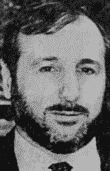
DiGilio
New Jersey ILA official Donald Carson of Scotch Plains was accused in November 1986 of conspiring with Bayonne-based Genovese soldier John DiGilio, then 53, in the extortion of $170,000 from a local stevedore company. Company payoffs allegedly were funneled through a trucking company controlled by a DiGilio ally, with a large portion of them passing through go-between John "Sausage" Barbato to Venero Mangano. Also charged in the federal case were Anthony Gallagher of Bayonne, Gallagher's cousin Anthony Sharkey, also of Bayonne, and Barbato. Mangano was named as an unindicted co-conspirator. [35]
Despite his underworld status of soldier (he claimed to have refused an offer of promotion), DiGilio commanded a branch of the Genovese Crime Family in the Bayonne area. A former middleweight boxer, he was reportedly first inducted into the Bonanno Crime Family and later switched allegiance to the Genovese clan. He served for a time under the leadership of capodecina Pasquale "Patty Mack" Macciarole and managed to survive Macciarole's fatal falling out with Mafia bosses. In July 1975, DiGilio was convicted of bribing an FBI clerk-typist to obtain copies of FBI files related to his criminal activities. A successful appeal reduced his sentence in that case from nine years to nine months. By feigning illness, DiGilio avoided starting his prison term until 1981. [36]
In this period, the FBI began receiving more reliable information on Genovese Family leaders and their activities. One of their sources was civil rights activist Rev. Al Sharpton. Sharpton is said to have forwarded to the FBI information on Genovese mobsters obtained from crime family associate Joseph Buonanno. (Sharpton did not deny aiding FBI investigations but publicly insisted that his role was exaggerated.) The data prompted the FBI to place surveillance at two social clubs, to bug several automobiles and to tap more than a dozen telephone lines. The Bureau refined its view of Genovese leadership and caused it to target Vincent Gigante, Venero Mangano and "Baldy Dom" Canterino. [37]
The FBI also secured the assistance of Peter "Blackheart" Savino as a confidential informant. Savino confessed his dealings with Genovese gangsters and wore a concealed recording device during meetings with higher-ups. One 1987 recording captured Venero Mangano lecturing Savino on his untrustworthy pals. Savino protested that he was different from the men he hung around with, and Mangano responded, "Show me your friends, and I'll tell you who you are." [38]
A month before his federal extortion conspiracy trial opened, John DiGilio was convicted in a New Jersey court of conspiracy to commit loan sharking, a trial he had successfully dodged through claims of ill health since 1978. Sentencing was set for a later date. [39] On November 16, 1987, trial opened in Newark federal court for DiGilio and his extortion conspiracy codefendants.
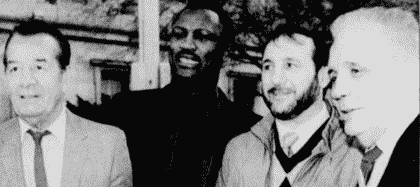
Rocco Graziano, Joe Frazier, John DiGilio, Jake LaMotta
(Asbury Park Press, Nov. 25, 1987)
DiGilio made a spectacle of the legal proceedings. He insisted on serving as his own defense attorney, he antagonized prosecutors, he was accessible to the press and he invited well-known boxing celebrities, including Muhammad Ali, Joe Frazier, Rocky Graziano and Jake LaMotta, to show their support by attending the trial.
The prosecution presented tape recordings of DiGilio conversations, in which the underworld figure asserted, "Bayonne is mine." Additional recorded comments may have been a greater concern to Genovese Family higher-ups, as they contained a demeaning reference to Venero Mangano: "Don't nobody, you know, not Benny Mangano, not anybody, no, I'm the only tough guy in Bayonne. For years I've been chiselin', comes to a thousand a week." DiGilio brushed off the taped conversations as just boastful "lockerroom talk," but by mocking Mangano the ex-pugilist was clearly punching above his weight. Prosecutors also presented evidence of DiGilio control of regional rackets and waterfront union officials.
On April 16, a federal jury acquitted DiGilio. It convicted just Donald Carson and Anthony Gallagher of extortion conspiracy. DiGilio quickly left the courtroom after the verdict was announced. [40]
The "only tough guy in Bayonne" disappeared about three weeks later. He was reported missing by his wife Ellen on Saturday, May 7, 1988. She last saw him at their Holmdel, New Jersey, home at eight o'clock the previous morning. On May 19, DiGilio failed to appear for his sentencing hearing for the recent loan shark conspiracy case. His attorney, Larry Bronson, expressed concern for his client's well-being: "He has never run away from a jail sentence or anything. The only conclusion I can come to is that something untoward has happened to John DiGilio." Authorities speculated that DiGilio's attention-getting behavior in his recent trials had convinced mob bosses that he needed to be eliminated. [41] The disrespectful comments he made on government recordings were also likely a factor.

(Allentown Morning Call, May 27, 1988)
The body of John DiGilio was found on the morning of May 26 within a mortician's bag, floating in the Hackensack River at Carlstadt, New Jersey. A fisherman near the foot of Paterson Plank Road, a short distance from the Meadowlands Sports Complex, spotted the bag and alerted authorities. Police found that DiGilio had been shot at least twice in the head. (It was later revealed that five bullets were fired into his head. A Genovese associate named Louis J. Auricchio, Jr., claimed responsibility for the killing in 1994.) One of DiGilio's credit cards was found placed between his legs by the killer, who apparently wished to ensure that the victim's identity was known. Police also identified the decomposed remains through fingerprints. Following a postmortem examination, state and county medical examiners announced that DiGilio had been shot numerous times in the head and face and his body left in the river water for an extended time.
New Jersey State Police Superintendent Clinton Pagano gave the press his opinion of the murder: "[DiGilio] met his death because of the way he operated and they just couldn't tolerate it. You don't become a media celebrity. You don't do foolish things to rankle law enforcement. ... He was violent. He was devious. He manufactured a way to escape the law, but he couldn't manufacture a way to escape his associates." [42]
Underboss
Vincent Gigante's role as Genovese Family boss was undeniable following the 1986 federal conviction of Gigante front man Anthony "Fat Tony" Salerno. As Salerno received a 100-year prison sentence for participating in the Mafia Commission and another 70-year sentence in another racketeering case, federal investigators accumulated evidence that Salerno had only been a shield for Gigante. They also learned that Gigante's old friend, Venero "Benny Eggs" Mangano was serving as underboss.
When Gigante became ill and underwent heart surgery in the summer of 1988, Mangano stepped in to control the Genovese operations. As Gigante recovered, he and Mangano appeared to share power. [43]
In June 1989, another Al Sharpton connection with Genovese mobsters became apparent. As a Rockland County, New York, grand jury indicted five people for participating in a criminal enterprise, it was said that the group attempted to use a National Youth Movement bank account to launder its money. The National Youth Movement had been founded years earlier by the Rev. Sharpton. This may have prompted Sharpton to cooperate further in probes of the Genovese organization. The indictment noted Gigante's role as boss but made no mention of Mangano. It did label Dominick "Baldy Dom" Canterino as a top capodecina in the crime family. [44]
New York crime families had been siphoning money from New York City Housing Authority window replacement projects for a dozen years before the racket was finally halted in March of 1990. Leaders of four crimes families were among the 15 men indicted on racketeering, mail fraud and Taft-Hartley labor-management violations. The initial defendants in the "Window Case" were
- Genovese Family boss Vincent "Chin" Gigante.
- Genovese underboss Venero "Benny Eggs" Mangano.
- Genovese capodecina Dominic "Baldy Dom" Caterino.
- Genovese capodecina Joseph Zito.
- Lucchese Family boss Vittorio "Vic" Amuso.
- Lucchese underboss Anthony "Gaspipe" Casso.
- Lucchese capodecina Peter "Fat Pete" Chiodo.
- Lucchese associate John "Sonny" Morrissey.
- Lucchese associate Joseph "Joe Cakes" Marion.
- Gambino acting boss Peter Gotti.
- Gambino associate Caesar Gurino.
- Colombo Family consigliere Benedetto "Benny" Aloi.
- Colombo soldier Dennis DeLucia.
- Colombo associate Vincent "Three Fingers" Ricciardo.
- Business agent Thomas McGowan, Local 580, Architectural and Ornamental Ironworkers Union.
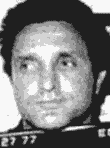
Amuso
Prosecutors said the group comprised a cartel that monopolized the selection of window replacement firms on more than 75 percent of the $191 million in window replacement contracts and forced the firms to provide kickbacks through installer unions. Much of the $142 million involved in the racket came from federal funds. [45]
Lucchese leaders could not be located. Amuso and Casso had apparently been alerted to the indictment and went into hiding. Associate Morrissey, a member of Local 580, also could not be found (killed on orders of Amuso and Casso and with the assistance of Chiodo, his buried body was located in the summer of 1991). Lucchese capodecina Peter Chiodo quickly pleaded guilty to the charges against him.
Other underworld leaders were processed. Gigante was sent to a Westchester hospital for a mental evaluation and was removed from the case when doctors found him unfit to stand trial. Mangano and Aloi were released on bail. Their free movement was curtailed with a court-ordered house arrest.
New York Mafiosi quickly learned that informants among them had assisted in the Window Case investigation. Former Genovese associate Peter Savino's defection was revealed, and an effort was made to prevent Savino from appearing in the case. Mangano and Gigante conspired with leaders of the Gambino and Lucchese families in an unsuccessful plot to have Savino killed. They then turned their attention to his family. Early in August 1990, a gasoline bomb was found in a car belonging to Savino's estranged wife. [46]
Ten defendants were in the Brooklyn Federal Court when Window Case jury selection began on April 8, 1991. The opening round of the government's case consisted of establishing the existence, membership and activities of the Mafia. Former Philadelphia Mafia leader Philip Leonetti described his own experiences in the underworld and told of his acquaintance with some defendants. He described "Benny Eggs" Mangano as a captain in the Genovese Family. [47]
The prosecution's key witness, Peter Savino, went to the witness stand on May 6. He was examined and cross-examined until June 28. Savino provided the details of bid-rigging scheme and also described Venero Mangano's insistence that the lion's share of the proceeds go to the Genovese Family. When Lucchese and Gambino leaders sought to increase their involvement, Mangano reportedly put his foot down: "It's all ours. Nobody's supposed to touch it." [48]

Chiodo
Only two days after Savino began his testimony, Lucchese capodecina Peter Chiodo was attacked by two gunmen as he worked on his car at a Staten Island service station. Chiodo had pleaded guilty to Window Case charges, and his bosses apparently thought he was cooperating with the investigation (he reportedly was not) and sent the gunmen to prevent him from appearing on the witness stand. The massive Chiodo was shot twelve times - hit in the chest, stomach, neck, arms and legs - but survived. Federal agents subsequently uncovered a plot to kill Chiodo at the hospital. [49]
The effort to prevent Chiodo from becoming a witness had the opposite effect. In September, the Window Case trial was moved temporarily from Brooklyn to the City of White Plains, in Westchester County, to allow for secure testimony from Chiodo. Recovering from his many gunshot wounds, Chiodo told of his background in the Mafia and his roles in the bid-rigging racket. He identified Venero Mangano as a top man in the Genovese Family and in the Window scheme. [50]
Just eight defendants remained through the end of the trial. Canterino and Ricciardo were dropped as defendants after suffering heart attacks. On October 18, 1991, the federal jury acquitted five of the remaining defendants and convicted just Venero Mangano, Benedetto Aloi and Dennis DeLucia. [51]
In March of 1993, Judge Ramond J. Dearie sentenced the three racketeers. Aloi, 58, received a sentence of 16 years and eight months in prison and a $100,000 fine. Mangano, 71, received 15 years and eight months in prison and a $100,000 fine. DeLucia received three years and ten months in prison and a $25,000 fine. [52]
'Tell people I'm crazy'
Peter Savino was seen again at Brooklyn Federal Court on July 17, 1997, as he testified in the government's case against sixty-nine-year-old Vincent "the Chin" Gigante. Savino outlined Genovese Family criminal activity and described family efforts to protect Gigante from law enforcement scrutiny.
Savino testified that in 1986 or 1987 the boss encouraged him to circulate the story that he was insane. "Don't be afraid to tell people I'm crazy," Gigante said, "because you know I'm crazy, don't you?"
The witness also described a scolding he received from Venero Mangano after accidentally mentioning the name "Vincent." Genovese Family members were instructed never to use Gigante's name in any form. Mangano silenced Savino with, "Don't mention that guy."
At the time of his testimony, Savino, 54, was suffering from advanced cancer and appeared in the courtroom only through closed-circuit television transmission from an undisclosed location in another state. He was under the protection of doctors and federal marshals. He had been in the federal witness security program since 1989.
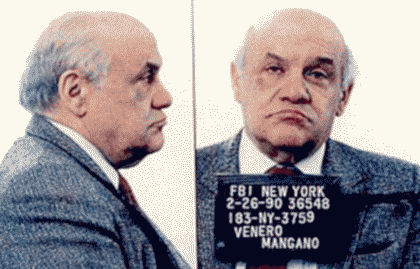
Mangano
On the same day as Savino's testimony, prosecutors made a surprise announcement: They planned to put Genovese Crime Family underboss Venero "Benny Eggs" Mangano on the witness stand to testify against his boss. They revealed that the Justice Department was prepared to offer the aging Mafioso full immunity from prosecution for anything he might reveal on the stand. Mangano had never provided any assistance to prosecutors previously, and it seemed doubtful that he ever would do so. Judge Jack Weinstein scheduled a hearing for the following day to determine Mangano's suitability as a government witness. [53]
On July 18, short, bald, Benny Eggs was brought to the court. Describing Gigante only as "a mental case," Mangano outright refused to testify in the case and joked about the court's inability to compel him to testify: "What do you want to do, shoot me? Shoot me, but I'm not going to answer any questions. I'm tired of these charades. You gave me fifteen years already. I'm seventy-six. Where am I going?"
Judge Weinstein had no choice but to find Mangano in contempt. However, the judge imposed no penalty on the uncooperative Mafia leader. [54]
After a month-long trial, which included testimony from Gambino Family turncoat Salvatore "Sammy the Bull" Gravano and accusations that Gigante had once ordered the killing of Gambino boss John J. Gotti, the jury began its deliberations on July 23. Two days later, it returned with a guilty verdict on racketeering and conspiracy charges but a not-guilty verdict relating to murder counts. [55] Gigante was not yet sentenced when the man authorities said was standing in for him as Genovese acting boss, forty-year-old Liborio "Barney" Bellomo of Pelham Manor, pleaded guilty to extortion conspiracy and was sentenced to ten years in federal prison. Also in that period, Peter Savino, the informant who devastated the Genovese Family leadership, passed away. Savino's September 30, 1997, death was noted in court documents filed by federal prosecutors at the end of October. [56]
Judge Weinstein sentenced Gigante on December 18, 1997, to twelve years in prison and a $1.25 million fine. The sentence was considerably less than the twenty-two to twenty-seven years specified in federal sentencing guideless and the thirty years called for by prosecutors. The judge said he adjusted the sentence due to Gigante's age and poor physical condition. During Gigante's imprisonment, Greenwich Village lost much of its importance to the crime family. Dominick "Quiet Dom" Cirillo of the Bronx took charge of day-to-day operations of the organization. [57] Another three years were added to Gigante's prison term in April 2003 when he finally admitted obstructing justice by feigning insanity - a routine that had earned him the newspaper nickname of "Oddfather" - during the 1990s. "The Chin" died in a federal prison medical center at Springfield, Missouri, on December 19, 2005. [58]
Last years
Venero Mangano's health was often an issue during his imprisonment. He reportedly suffered two heart attacks and had three surgeries during his prison term.
He was moved from federal prison to a federally run halfway house in Brooklyn on May 3, 2006. Reports indicated that he was suffering from problems with his heart and his eyesight. He was visited by his son Joseph and daughter Rosanna, who were permitted to drive him from the facility to his frequent doctor visits and therapy sessions. Louise Brunelli Mangano, Venero's wife for nearly fifty-four years, was unable to visit. She was ailing and could not leave home. [59]
Mangano was formally freed, November 2, 2006, after serving thirteen years of his sentence. (He may have served the final month of that term under house arrest.) He was ninety-five years old, but authorities believed he immediately returned to an administrative role in the Genovese Crime Family. [60]
A year later, Peter Chiodo was finally sentenced for offenses he admitted to in connection with the Windows Case and in his appearance as a witness against Venero Mangano and his co-defendants. The court imposed no jail time against Chiodo, who was in the witness security program. [61]
Gigante's old Triangle Social Club, symbol of the historic Genovese Family presence in Greenwich Village, was gradually emptied and abandoned. The location became a tea and spice retailer in March 2011. The Smoking Gun website marked the occasion with a story headlined, "The last great Mafia social club gets clipped." [62]
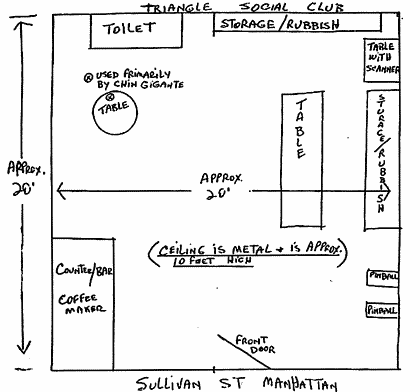
Triangle Social Club
(The Smoking Gun)
Benny Eggs was mentioned in the news a few times in the period 2012 to 2014. The mentions related to the conviction and sentencing of Frank "Frankie D" DiMattina for the attempted extortion of a rival for a State Island Catholic school lunch contract. Law enforcement and the press linked DiMattina, reputed Genovese Family associate, with two longtime Genovese mobsters. He was said to be in regular contact with John "Johnny Sausage" Barbato, and DiMattina's wife was said to be a relative of Venero "Benny Eggs" Mangano. The investigation of the DiMattina matter was nicknamed "Sausage and Eggs." [63]
The passing of Mangano in August 2017 was noted in the New York Daily News. The newspaper stated that Mangano died in Greenwich Village, where he has spent most of his life. It called Mangano "resolutely old school" and noted his lifelong adherence to the underworld code of omerta. [64]
Notes
1 McShane, Larry, "Venero (Benny Eggs) Mangano, Genovese underboss, dead at 95," New York Daily News, Aug. 18, 2017.
2 Passenger manifest of S.S. Providence, departed Palermo on March 30, 1924, arrived New York City on April 12, 1924. The Mangano family returned to the U.S. aboard the S.S. Providence after a visit of several months to relatives in Sicily.
3 New York City Marriage Index, certificate no. 31045, Ancestry.com.
4 United States Census of 1920, New York State, New York County, Assembly District 2, Enumeration District 194.
5 United States Census of 1920, New York State, New York County, Assembly District 2, Enumeration District 194. It appears that Carmela Pagano Mangano's mother was known as Antoinette Lamera (or Lamare/Lamari), a fifty-seven-year-old widow living with her daughter Angelina and son-in-law Joseph Bonano.
6 World War II Army Enlistment Records, Ancestry.com. Other sources place his birth in 1922.
7 Salvatore Esposito Vulgo Gigante Naturalization Petition, U.S. District Court for Southern District of New York, no. 90039, filed Nov. 3, 1926.
8 Passenger manifest of S.S. Providence.
9 United States Census of 1930, New York State, New York County, Assembly District 2, Enumeration District 31-68.
10 United States Census of 1930, New York State, New York County, Assembly District 2, Enumeration District 31-73. The story of Venero Mangano's nickname generally indicates that his mother ran the egg store. This was likely following the death of his father. The 1930 Census shows Benny's father, "Joseph Mangano," 42, worked as proprietor of an egg store.
11 Behar, Richard, "Special report. Organized crime," TIME, June 24, 2001.
12 McShane, "Venero (Benny Eggs) Mangano, Genovese underboss, dead at 95."
13 Salvatore E.V. Gigante World War II draft registration card, serial no. U1194, 1942.
14 Manhattan New York City Telephone Directory, May 1948, New York: New York Telephone Company, 1948, p. 869. This building may have been owned by the Mangano family at the time. The 166 Thompson Street address appeared in New York Times property transfers in March 1956 as it was passed from Venero Mangano to Salvatore Mangano. A three-story, multi-unit apartment building, built in 1900, stands at that address today.
15 "Venero Frank Mangano," New Jersey Division of Gaming Enforcement Exclusion List, Office of the Attorney General, www.state.nj.us/oag/ge/exclude_home.htm, accessed Aug. 27, 2017.
16 "Lucania sentenced to 30 to 50 years; court warns ring," New York Times, June 19, 1936, p. 1; Receiving blotter, Chas. Luciano, no. 92168, Sing Sing Prison, June 18, 1936; "Dewey commutes Luciano sentence," New York Times, Jan. 4, 1946, p. 25; "Salvatore Lucania...," FBI report NY 62-8768, file no. 39-2141-9, May 5, 1946, p. 9.
17 Passenger manifest of S.S. James Lykes, departed Bari, Italy, on May 17, 1945, arrived New York on June 1, 1945. Grutzner, Charles, "Rules 'Family' of 450," New York Times, Feb. 15, 1969, p. 1; "Genovese is freed of murder charge," New York Times, June 11, 1946; "Genovese free in murder case," New York Sun, June 10, 1946, p. 1; "Jury frees Gigante in Costello shooting," New York Times, May 28, 1958, p. 1.
18 "Venero Frank Mangano," New Jersey Division of Gaming Enforcement Exclusion List.
19 New York City Marriage Index, certificate no. 28037, Ancestry.com; United States Census of 1930, New York State, New York County, Assembly District 2, Enumeration District 31-63; Capeci, Jerry, "Rough prison treatment for a fragile Benny Eggs," New York Sun, Sept. 21, 2006.
20 Behar, "Special report. Organized crime."
21 Vines, Steve, "Mafia riddle of Murdoch trucks," London England Observer, Feb. 9, 1986, p. 7.
22 Demaris, Ovid, The Last Mafioso: The Treacherous World of Jimmy Fratianno, New York: Times Books, 1981, p. 323. Fratianno's description of the cafe is similar to the layout of the Triangle Social Club, 208 Sullivan Street, long used as a base by Vincent Gigante. Fratianno recalled that the cafe was about a five-minute walk from the clothing store. The distance to Triangle Social Club was about one-half mile, or about a 10-minute walk.
23 Audio: The UNIRAC investigation," Federal Bureau of Investigation, FBI.gov, Dec. 19, 2008, accessed Aug. 30, 2017; FBI 100: On the Waterfront, Mafia-Style," Federal Bureau of Investigation, FBI.gov, Dec. 16, 2008, accessed Aug. 30, 2017.
24 Behar, "Special report. Organized crime."
25 Behar, "Special report. Organized crime."
26 "Venero Frank Mangano," New Jersey Division of Gaming Enforcement Exclusion List.
27 "Possible mob links under Dallas probe," Shreveport LA Times, Nov. 2, 1981, p. 9.
28 "Last great Mafia social club gets clipped," The Smoking Gun, thesmokinggun.com, April 18, 2011, accessed Aug. 18, 2017.
29 Raab, Selwyn, Five Families: The Rise, Decline, and Resurgence of America's Most Powerful Mafia Empires, New York: Thomas Dunne Books, 2006, p. 541-542.
30 Raab, Selwyn, Five Families, p. 543.
31 "TNT refutes 'mafia' claim," Sydney Australia Morning Herald, July 25, 1982, p. 27.
32 "The Mafia in New Jersey," Camden NJ Courier-Post, Feb. 20, 1983, p. 6.
33 Gold, Jeffrey, "Golden Nugget's Wynn has come a long way from the bingo parlor," Asbury Park NJ Press, Aug. 31, 1986, p. 1; Carvajal, Doreen, "Casino host testifies that he did not ask about crime ties," Philadelphia Inquirer, Aug. 29, 1986, p. 7B.
34 "Venero Frank Mangano," New Jersey Division of Gaming Enforcement Exclusion List.
35 Andreassi, George, "Union officer accused of conspiracy," Philadelphia Inquirer, Nov. 6, 1986, p. 2BJ; "8 indicted in mail fraud scheme in handling of freight in Bayonne," New York Times, Nov. 6, 1986.
36 Gentry, Margaret, "N.J. policeman tells how he infiltrated mob," Philadelphia Inquirer, Feb. 27, 1981, p. 10A; "DiGilio is facing prison 6 years after conviction," Asbury Park NJ Press, March 3, 1981, p. 31; "Tieri sentenced to 10 years in murder conspiracy, extortion," Asbury Park NJ Press, Jan. 24, 1981, p. 12; Wakin, Daniel J., "The climb and fall of John DiGilio," Philadelphia Inquirer, May 29, 1988, p. 11-B.
37 "Al Sharpton's secret work as FBI informant," The Smoking Gun, www.thesmokinggun.com/documents/investigation/al-sharpton-764312 , April 7, 2014, accessed Aug. 18, 2017; Campanile, Carl, and Kate Sheehy, "Sharpton secretly worked as FBI mob informant: report," New York Post, April 7, 2014; Barron, James, "Sharpton is linked to spying on the Mafia," New York Times, April 7, 2014.
38 Behar, "Special report. Organized crime;" Capeci, Jerry, "This week in gangland: the prosecutor," IPSN.org, Dec. 21, 1998, accessed Aug. 27, 2017.
39 Murray, Brian, "Nine years after arrest, DiGilio goes on trial," Morristown NJ Daily Record, May 7, 1987, p. B1; Harnes, John A., "Autopsy shows DiGilio died of gunshot wounds," Asbury Park NJ Press, May 28, 1988, p. A3.
40 Wakin, Daniel J., "The climb and fall of John DiGilio," Philadelphia Inquirer, May 29, 1988, p. 11-B; "Racketeering trial begins in Newark," Asbury Park NJ Press, Nov. 16, 1987, p. 3; "Jury hears tape of mob defendant," Asbury Park NJ Press, Dec. 23, 1987, p. C14; "Reputed mobster acquitted by jury," New York Times, April 17, 1988.
41 "New Jersey mob figure is missing from home," New York Times, May 9, 1988; Harnes, John A., "Autopsy shows DiGilio died of gunshot wounds," Asbury Park NJ Press, May 28, 1988, p. A3; Wakin, Daniel J., "DiGilio a no-show at court sentencing," Rockland County NY Journal-News, May 20, 1988, p. 11.
42 "Body of a reputed mobster is found in a bag in river," New York Times, May 27, 1988; Harnes, John A., "Autopsy shows DiGilio died of gunshot wounds;" Katsarelas, Nicholas G., "Official vows vigorous probe into death of mob figure," Philadelphia Inquirer, May 28, 1988, p. 1.
43 Raab, Selwyn, "Investigators say they're ready to topple new Mafia chiefs," New York Times, Dec. 12, 1988.
44 Feron, James, "5 are indicted as participants in rackets ring," New York Times, June 13, 1989.
45 Raab, Selwyn, "Suspected New York mob leaders are indicted in contract rigging," New York Times, May 31, 1990.
46 Raab, Selwyn, "F.B.I. sees Mafia splintered and ripe for power clashes," New York Times, Dec. 17, 1990; Lubasch, Arnold H., "Mob murder is recounted by organizer," New York Times, May 22, 1992; Raab, Selwyn, Five Families, p. 589-591; "Judge: No evidence tying mobsters to car bomb," Central New Jersey Home News, Aug. 15, 1990, p. 15; Lubasch, Arnold H., "Selection of jury gets under way in big-rigging case tied to mob," New York Times, April 9, 1991; "4 Mafia figures on trial for window racketeering," Lincoln NE Journal Star, April 24, 1991, p. 9.
47 Lubasch, Arnold H., "Ex-mob leader, in trial, recalls his life of crime," New York Times, April 26, 1991.
48 Lubasch, Arnold H., "Reporter's Notebook: 2 months as a star witness at Mafia big-rigging trial," New York Times, June 28, 1991; Raab, Selwyn, Five Families, p. 589.
49 Lubasch, Arnold H., "Mafia captain is prosecution witness," New York Times, Sept. 12, 1991; Marzulli, John, "Peter (Big Pete) Chiodo sentenced 17 years after arrest," New York Daily News, Sept. 11, 2007.
50 Lubasch, Arnold H., "Mafia captain is prosecution witness."
51 Lubasch, Arnold H., "Windows jury finds 3 guilty and acquits 5," New York Times, Oct. 19, 1991; Jacobs, James B., with Coleen Friel and Robert Radick, Gotham Unbound: How New York City was Liberated from the Grip of Organized Crime, New York: New York University Press, 1999, p. 212.
52 "2 men sentenced in 'Windows Trial,'" New York Times, March 28, 1993.
53 Fried, Joseph P., "Former mobster directly links Gigante to murder," New York Times, July 18, 1997.
54 Fried, Joseph P., "A jailed mobster refuses to testify in Mafia case," New York Times, July 19, 1997; McShane, "Venero (Benny Eggs) Mangano, Genovese underboss, dead at 95."
55 "Jury in Gigante trial begins deliberations," New York Times, July 24, 1997; Fried, Joseph P., "Jurors find Gigante guilty of racketeering, not murder," New York Times, July 26, 1997; Fried, Joseph P., "Ex-mobster testifies that Gigante backed a plot to kill Gotti," New York Times, July 16, 1997; Fried, Joseph P., "Ex-mob killer tells of profits in book deal," New York Times, July 11, 1997.
56 "Genovese crime figures given federal sentences," New York Times, Sept. 23, 1997; Fried, Joseph P., "Peter Savino, Mafia associate who became an informer, 55," New York Times, Nov. 1, 1997; "Peter Savino, 55, Mafia associate," Morristown NJ Daily Record, Nov. 3, 1997, p. 15; "Mafia associate Peter Savino, at 55," West Palm Beach FL Post, Nov. 1, 1997, p. 14.
57 Fried, Joseph P., "Gigante sentenced to 12 years and is fined $1.25 million," New York Times, Dec. 19, 1997; Behar, "Special report. Organized crime."
58 Raab, Selwyn, "Vincent Gigante, Mafia leader who feigned insanity, dies at 77," New York Times, Dec. 19, 2005; "Ex-Mafia boss Vincent Gigante dies in prison," NBCNews.com, Dec. 19, 2005.
59 Capeci, "Rough prison treatment for a fragile Benny Eggs."
60 "Find an inmate," Federal Bureau of Prisons, bop.gov; McShane, "Venero (Benny Eggs) Mangano, Genovese underboss, dead at 95."
61 Marzulli, John, "Peter (Big Pete) Chiodo sentenced 17 years after arrest."
62 "Last great Mafia social club gets clipped," The Smoking Gun, thesmokinggun.com, April 18, 2011, accessed Aug. 18, 2017.
63 Marzulli, John, "Caterer with mob ties gets cooked," New York Daily News, Jan. 6, 2012; Marzulli, John, "Mob-tied caterer was sentenced to 6 years in prison for extortion," New York Daily News, March 31, 2012; Algar, Selim, "Restaurateur freed because his gunpoint extortion attempt failed," New York Post, July 30, 2014.
64 McShane, "Venero (Benny Eggs) Mangano, Genovese underboss, dead at 95."